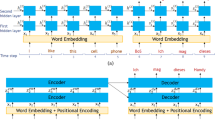Abstract
We present a new stopping criterion for the matching pursuit (MP) algorithm, based on evaluating stationarity of the residua of the consecutive MP iterations. The new stopping criterion is based on a model of a nonstationary signal, which assumes that the part of the signal that is of interest is nonstationary and contaminated by a weakly stationary noise. Mean- and variance-stationarity of the residua obtained from each step of MP is evaluated by means of dedicated statistical tests—the Kwiatkowski–Phillips–Schmidt–Shin (KPSS) test and the White test, respectively. We illustrate the proposed concept by an example in which we analyse magnetoencephalographic (MEG) data.
Similar content being viewed by others
References
Bénar CG, Papadopoulo T, Torrésani B, Clerc M (2009) Consensus matching pursuit for multi-trial EEG signals. J Neurosci Methods 180: 161–170
Durka PJ (2007) Matching pursuit and unification in EEG analysis. Artech House, Boston
Durka PJ, Matysiak A, Martínez-Montes E, Valdés-Sosa P, Blinowska KJ (2005) Multichannel matching pursuit and EEG inverse solutions. J Neurosci Methods 148(1): 49–59
Jörn M, Sielużycki C, Matysiak MA, Żygierewicz J, Scheich H, Durka PJ, König R. Single-trial reconstruction of auditory evoked magnetic fields by means of template matching pursuit. J Neurosci Methods 199(1):119–128
Kipiński L (2007) Time series analysis of nonstationary data in encephalography and related noise modelling. In: Jabłoński R, Turkowski M, Szewczyk R (eds) Recent advances of mechatronics. Springer, Berlin, pp 238–242
Kipiński L (2008) A new stopping criterion for the matching pursuit algorithm. In: Tkacz R, Komorowski D, Kostka P, Budzianowski Z (eds) Proceedings of the IX international conference symbiosis 2008, pp 53–55
Kipiński L, König R, Sielużycki C, Kordecki W (2011) Application of modern tests for stationarity to single-trial MEG data. Transferring powerful statistical tools from econometrics to neuroscience. Biol Cybern. doi:10.1007/s00422-011-0456-4
König R, Sielużycki C, Simserides C, Heil P, Scheich H (2008) Effects of the task of categorizing FM direction on auditory evoked magnetic fields in the human auditory cortex. Brain Res 1220: 102–117
Kwiatkowski D, Phillips PCB, Schmidt P, Shin Y (1992) Testing the null hypothesis of stationarity against the alternative of a unit root. J Econom 54: 159–178
Mallat S, Zhang Z (1993) Matching pursuits with time–frequency dictionaries. IEEE Trans Signal Process 41: 3397–3415
Matysiak A, Durka PJ, Martínez-Montes E, Barwiński M, Zwoliński P, Roszkowski M, Blinowska KJ (2005) Time–frequency–space localization of epileptic EEG oscillations. Acta Neurobiol Exp 65(4): 435–442
Sielużycki C, König R, Matysiak A, Kuś R, Ircha D, Durka PJ (2009a) Single-trial evoked brain responses modeled by multivariate matching pursuit. IEEE Trans Biomed Eng 56(1): 74–82
Sielużycki C, Kuś R, Matysiak A, Durka PJ, König R (2009b) Multivariate matching pursuit in the analysis of single-trial latency of the auditory M100 acquired with MEG. Int J Bioelectromagn 11(4): 155–160
White H (1980) A heteroskedasticity-consistent covariance matrix estimator and a direct test for homoskedasticity. Econometrica 48: 817–838
Żygierewicz J, Durka PJ, Klekowicz H, Crone N, Franaszczuk P (2005) Computationally efficient approaches to calculating significant ERD/ERS changes in the time–frequency plane. J Neurosci Methods 145: 267–276
Żygierewicz J, Sielużycki C, König R, Durka PJ (2008) Event-related desynchronization and synchronization in MEG: framework for analysis and illustrative datasets related to discrimination of frequency-modulated tones. J Neurosci Methods 168: 239–247
Author information
Authors and Affiliations
Corresponding author
Additional information
L. Kipiński—formerly at Institute of Biomedical Engineering and Instrumentation, Wrocław University of Technology, Wybrzeże Wyspiańskiego 27, 50–370 Wrocław, Poland.
Rights and permissions
About this article
Cite this article
Kipiński, L. Stationarity stopping criterion for matching pursuit—framework and encephalographic illustration. Biol Cybern 105, 287–290 (2011). https://doi.org/10.1007/s00422-011-0443-9
Received:
Accepted:
Published:
Issue Date:
DOI: https://doi.org/10.1007/s00422-011-0443-9




